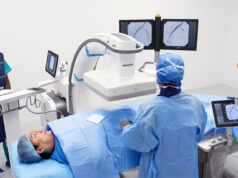
“The SAVER registry reinforces the safety and effectiveness profile for the Stellarex drug-coated balloon (DCB; Philips) in a real-world patient population,” Konstantinos Stavroulakis (St Franziskus Hospital–Vascular Surgery, Munich, Germany) told the live, online audience during the 2020 meeting of the Cardiovascular and Interventional Radiological Society of Europe (CIRSE; 12–15 September, virtual).
“These real-world registry data provide important outcome information for healthcare providers for the debate on the safety of drug-eluting technology,” he opined.
The Stellarex DCB is a low dose (2µg/mm2) paclitaxel device, with proven effective drug tissue transfer and residency. Compared to competitors, it has limited drug loss, “a very important feature”, in Stavroulakis words.
The SAVER registry
SAVER stands for the Stellarex Vascular e-Registry, a multicentre, European registry with external monitoring and clinical event committee adjudication. Patients are followed up through to three years, and experience a 12-month visit. The aim of the SAVER registry is to assess the safety and efficacy of Stellarex DCB use in the superficial femoral, popliteal, and/or infra-popliteal arteries in a broad, real-world patient population.
The registry is split into two patient cohorts: claudicants, and chronic limb-threatening ischaemia (CLTI) patients.
In the claudicant group—where patients are classified as Rutherford category 2–3—the primary safety endpoints are freedom from 30-day device- and procedure-related death, and freedom from 12-month target limb major amputation and clinically-driven target lesion revascularisation (CD-TLR). The efficacy endpoint for claudicants is freedom from 12-month CD-TLR.
In the CLTI group—where patients are classified as Rutherford category 4–5—the primary safety endpoints are freedom from composite major adverse limb events and perioperative death through 30 days. The efficacy endpoint for CLTI patients is freedom from six-month CD-TLR.
Registry results “robustly” demonstrate safety of the Stellarex DCB
An interim analysis of the first 1,000 claudicant patients revealed a procedural success of 97.9%, and lesion success in 98.5%. “Bailout stenting was required in 24% of the patients, showing that we can treat the majority of these PAD patients effectively, […] with no additional permanent scaffold,” Stavroulakis said.
Regarding complications, there was a 0% periprocedural mortality, and “just” 0.6% significant distal embolization. Target vessel thrombosis was seen in 0.2% of the patient cohort, and emergent surgical revascularisation in 0.1%.
The majority of patients (87.4%; 892 of 1,021) reached the primary safety endpoint, with freedom from device- and procedure-related death through 30 days post-procedure, and freedom from target limb major amputation and CD-TLR through 12 months post-procedure. Giving additional outcomes at one-year, Stavroulakis told the CIRSE audience that all-cause death was 3.2%, and amputation rate was 2.7%, with the major amputation rate 0.8%—“acceptable” outcomes in this real-world population.
Regarding the efficacy endpoint, 87.7% (895 of 1,021) patients had freedom from CD-TLR at 12-months post-procedure, a “robust” finding, according to Stavroulakis. Kaplan-Meier evaluation demonstrated 98.7% freedom from CD-TLR at 30 days, 95% at 180 days, and 88.6% at 365 days.
Recounting the additional secondary outcomes, Stavroulakis told registrants that the majority of patients (87.6%) improved by at least one Rutherford class; 8.9% had no change in Rutherford category, and 3.5% worsened from baseline. There was a significant improvement in walking capacity at 12 months, as measured via the six-minute walk test: at baseline, the mean distance a patient could walk during the test was 52±24.4m; by 12 months, this had risen to 169±123.7m. Quality of life scores and the ankle-brachial index also improved from baseline to 12 months.
These results led Stavroulakis to conclude that there was a low rate of procedural complications when the Stellarex DCB was used in claudicants, and the device had a high safety profile.













